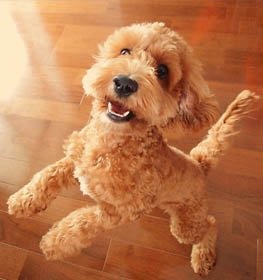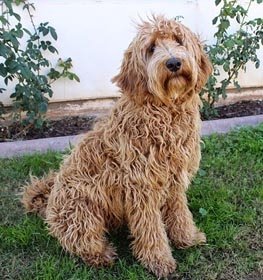Mastador Information & Dog Breed Facts
Collection of all the general dog breed info about Mastador so you can get to know the breed more.
| Group | Designer Dogs |
|---|---|
| Popularity Rank | 573 |
| Reviews | 1 |
| User Ratings | |
|
Compare the Mastador With Other Dogs
Select at least one dog breed to make the comparsion. | |
 | |
| Origin | |
|
Common Names & Aliases
What other names is a Mastador known by? Discover all traditional, regional and informal names used for this breed. | Mastidor |
|---|---|
|
Breed Classification
What type of dog breed is a Mastador? Learn about its genetic classification and breeding category. | Cross Breed |
|
Size Classification
What size category is a Mastador? Learn how big the Mastador breed typically grows. | LargeGiant |
|---|---|
|
Weight Statistics
How much does a Mastador weigh? Discover typical weight ranges for adult males and females of the Mastador breed. | 85-160 pounds (39-73 kg) |
|
Average Weight
What is the average weight of a Mastador? | 122.5 pounds (56 kg) |
|
Height
How tall is the Mastador? Mastador height: | 28-36 inches (65-91 cm) |
|
Average Height
What is the average height of a Mastador? | 32 inches (78 cm) |
|
Price Range
How much does a Mastador puppy cost? Find current market prices and factors affecting Mastador costs. | $1000-$1500 If you choose to purchase the Mastador, you should know that the mentioned amount of money is an average of the collected data from breeders’ sites and puppy finder places. If you have a Mastador for sale, please advertise it on a reliable website to make sure the Mastador gets to a happy place. |
|---|---|
|
Availability
How easy is it to get a Mastador? How many Mastador are there in the world? | Average: The Mastador is a commonly available dog breed. There is less risk of overbreeding compared to the very popular dogs. Of course, they may be more popular in some countries, and inbreeding may occur, so be careful. |
|
Intelligence Rating
How intelligent is a Mastador? Discover the Mastador's intelligence ranking and learning capabilities. | Smart: The Mastador dogs have great intelligence. They understand and memorize new commands in 15-25 repetitions.
The Mastador is among the smartest dogs in the intelligence ranking. |
|---|---|
|
Training Difficulty
How easy is it to train a Mastador? Learn about the Mastador's trainability and response to training methods. | Mastador dogs are quite easy to train. Sometimes they can be challenging, but if you're consistent in teaching new commands they will obey for sure. |
|
Watchdog Rating
How good is a Mastador as a watchdog? Learn about the Mastador's alertness and guarding instincts. | Mastador dogs are average watchdogs. If they sense something different, they will alert you, but observation isn't considered their main job.
|
|
Territorial Protection
Is a Mastador protective of its territory? Learn about the Mastador's guarding instincts and behavior. | Mastador dogs are extremely protective guard dogs. This breed doesn't hesitate to protect its territory so the Mastador can be a good choice if you want an excellent guard dog. Keep calm and the Mastador will take care of unwanted people or animals. |
|
Personality Traits
What personality does a Mastador have? Learn about characteristic Mastador temperament and behavior traits. | ProtectiveSensitiveHuntingCompanionablePoliteGuardingShyFearful |
|---|---|
|
Sensitivity Level
How sensitive are they? Mastador sensitivity: | They are a little bit more sensitive than other dog breeds. Soft punishment affects them emotionally. Mastador dogs don't tolerate irregular daily routines, noisy households, and frequent guest visits really well.
They are receptive to their owner's emotions and make wonderful family companions. |
|
Affection Level
How affectionate are they? Is a Mastador a good family dog? | High: Mastador dogs are genuinely loyal, soft and gentle, loving, and affectionate dogs toward their handlers. They enjoy quality time with their owners despite the activity and are considered great therapy dogs for those in need. This breed responds strongly to their handler's emotions because they bond closely. Their happiness is your happiness. |
|
Social Needs
How much social interaction does the Mastidor need? Mastador social needs: | Mastador dogs need for social interaction is average. This breed likes being around people or other animals, but they don't mind being left alone for a few hours either. |
|
Impulse to Wander or Roam
How likely is the Mastador to run away? Does this breed explore or wander a lot? Does Mastador roam? | Mastador dogs tend to escape less than other breeds. They have low to average wanderlust potential. Exploring the world is not the best activity they can imagine. |
|
Prey Drive
Do this canine have a strong prey drive? Does Mastador have high prey drive? | Mastador dogs have low to an average impulse to chase and catch something like a cat or any other small aminals. |
|
Barking Frequency
Does a Mastador bark a lot? Learn about typical Mastador vocalization patterns and triggers. | Low to Average: The Mastador rarely barks. This breed could be a good choice if you're looking for a quiet breed. They don't bark unless there is a good reason.
Top reasons for barking: protection, alarm, fear, boredom, attention-seeking, greeting, separation anxiety, compulsive barking. |
|---|---|
|
Playful Nature
How playful is a Mastador? Understand the typical play drive and energy level of the Mastador breed. | The Mastador is a playful breed. Excited barking and sometimes nipping will alert you to play. |
|
Apartment Adaptability
Can a Mastador live in an apartment? Learn about the Mastador's suitability for apartment living. | Not an apartment-friendly dog the Mastador breed. If you don't have a garden, think carefully about your decision, keeping Mastador indoors can cause a lot of problems. |
|
Lifestyle Adaptability
How adaptable is a Mastador to lifestyle changes? Learn about the Mastador's flexibility to new situations. | Average: Mastador dogs adapt to lifestyle changes and different living environments quite okay usually. |
|---|---|
|
Alone Time Tolerance
Can a Mastador be left alone? Learn about the Mastador's tolerance to solitude. | Just like every puppy, they are prone to panic, cry, bark, whine when they left alone by their owner. With proper socialization and quality time with the dog can solve this problem. |
|
Bite Risk Assessment
What is a Mastador biting potential? Learn about the Mastador's bite risk factors. | Low 🔽 The Mastador has a low chance of biting somebody. Top reasons for dog bite: protection, pain, excitement, herding instinct, being provoked. (Data based on the available online bite statistics.) |
|---|---|
|
Mouthing Tendency
Is a Mastador mouthy? Learn about the Mastador's tendency to use mouth during play. | Mastador dogs have a higher than average tendency to nip, chew, playbite, or herd people. It's a common habit during puppyhood, not aggressive behavior. These "bites" don't hurt, but Mastador dogs need to be taught a good attitude. |
|
Bite Strength Rating
How strong is a Mastador bite? Learn about the Mastador's bite force measured in PSI. | Above 400 PSI 🔼 Mastador bite force: The Strongest. The Mastador bite force is among the strongest in the canine world. The bite force Mastador measurements are typically quite high, which is a testament to their powerful and large stature. The bite force of Mastador dogs is impressive, and their Mastador bite PSI is reflective of their powerful nature.
The Mastador PSI bite should be respected, and appropriate precautions should be taken when interacting with these dogs. The PSI of a Mastador bite is high, making them one of the strongest breeds in terms of bite force. They are very protective of themselves and their families, therefore a dog bite from them could be exceptionally dangerous with their PSI being above 400. To ensure a well-behaved and controlled dog, it's important to learn how to train a Mastador puppy not to bite from an early age. It is important that they’re trained to be around others safely. |
|
Average Lifespan
How long does a Mastador live? Learn about the typical lifespan of the Mastador breed. | 10-12 years The average lifespan of Mastador: 11 years |
|---|---|
|
Climate Tolerance
How well does a Mastador handle different weather? Learn about the Mastador's climate adaptability. | Prefers average to cold weather conditions The Mastador can adapt to well to cold weather conditions, some dogs even can be a good mountain dog. |
|
Health Concerns
What health issues are common in a Mastador? Discover typical conditions affecting the Mastador breed. | Mastadors are commonly healthy dogs. Vet costs aren't expensive with this breed. |
|
Vet Care Frequency
How often does a Mastador need vet visits? Learn about the Mastador's veterinary care requirements. | Rare The Mastador should have a complete physical check-up at least every 12-18 months (but preferably once per year). If your dog shows any symptoms, call your veterinarian. |
|
Health Problems
What genetic/health problems does the Mastador breed have? What are the health issues and concerns of the Mastador breed? Most common health risks of Mastador: | CataractsBloatElbow DysplasiaRetinal DysplasiaObesityPulmonic StenosisCanine Hip Dysplasia (CHD)Gastrointestinal Diseases |
|
Energy Rating
How energetic is a Mastador? Understand daily activity needs of the Mastador breed. | Mastador dogs have a higher energy level than other dog breeds. If you want a dog for snuggling on the couch, this breed isn't the perfect choice for you. |
|---|---|
|
Activity Requirement / Exercise Need
How much exercise does a Mastador need? How much exercise do Mastador dogs require per day?
Do Mastador dogs need a lot of exercises? | Mastador dogs need quite a lot of exercise. Daily walks should be on schedule. If you live an active life, this breed can be a good choice for you. |
|
Sleeping Need
How much sleep does the Mastador breed need? | Mastador dogs are quite energetic dogs and they don't spend too much time with sleeping. If you live an active life, this breed can be a good choice for you. |
|
Obesity Tendency
Is a Mastador prone to weight gain? Learn about the Mastador's obesity risks. | Average to High: If you don't pay attention to the Mastador's weight, he can easily gain weight. More than one daily walk should be on schedule. To make your dog happy and fit, feed him with quality dry dog food and live an active life together. Try to find the happy medium between exercise and feeding.
If you notice any weight gain, consult your veterinarian and make a diet plan. Reduce unhealthy food and snacks, and measure the Mastador weight regularly. |
|---|---|
|
Food Consumption
How much food does a Mastador need daily? Learn about the Mastador's feeding requirements. | 6 to 8 cups of high-quality dry food a day, divided into two meals. |
|
Allergy Friendliness
Is a Mastador hypoallergenic? Learn about the Mastador's suitability for allergy sufferers. | Yes Mastador dogs do well with allergy sufferers by causing fewer allergic reaction. However there are no 100% hypoallergenic dogs in the world, there are a variety of breeds that are considered to reduce or minimize the possibility of an allergic response. Coat type isn't necessarily relevant, because most people are allergic to dander (flakes on the dog's skin) or saliva, not actually to dog hair. Mastador dogs don't do well with allergy sufferers by causing allergic reactions. Some dog breeds are even considered to higher possibility of an allergic response. Coat type isn't necessarily relevant, because most people are allergic to dander (flakes on the dog's skin) or saliva, not actually to dog hair. |
|---|---|
|
Coat Colors
What colors does a Mastador come in? Discover all possible Mastador color variations. | BlackBrownYellow Brindle |
|
Grooming Requirements
How much grooming does a Mastador need? Learn about Mastador coat maintenance requirements. | Advanced: The Mastador requires a lot of grooming. Cutting the dog's hair by a professional groomer can be helpful sometimes. Regular brushed dog's coat is less likely to shed. Ears and eyes should be cleaned often to avoid infections. Don't skip the seasonal flea treatment too. Occasional dog nail trimming and dog baths are important.Check the local pet store for dog grooming supplies and find the best dog shampoo to keep its coat healthy and to give your Mastador a pleasant experience of a dog bath. If you don't have the time, skill, or money to take care of your Mastador, search for the best dog groomer or clipping service in your area and book an appointment. Maybe you're lucky to have a dog boarding service that includes grooming or walk-in dog bath places nearby. |
|
Drooling Tendency
Does a Mastador drool a lot? Learn about the Mastador's drooling habits. | The Mastador drools quite a lot, so if you dislike being covered by slobber spots on your clothes, you may want to choose another dog breed. Drooling is the unintentional saliva flowing outside of the mouth. It can be completely normal or a sign of a health problem. Certain dog breeds drool more than others, just like the Mastador.
If you notice any change in your dog's drooling habit, you should contact a vet as soon as possible. |
|
Stinkiness Rating
Does a Mastador smell bad? Learn about the Mastador's natural odor levels. | Low 🔽 The Mastador has a low chance of bad smell. Top reasons for dog stinkiness: infection of bad tooth/ear/skin folds, gas attacks. |
|
Coat Characteristics
What type of coat does a Mastador have? Learn about the Mastador's fur characteristics. | SilkyStraightShort |
|
Bathing Needs
How often does a Mastador need baths? Learn about the Mastador's bathing requirements. | 6-8 weeks Rarely. Bathing your dog is beneficial to them in more ways than just one. It’s also a good time to look for unusual scratches, bumps, fleas, and other irregularities. When their hair is wet and flat against their body, these details are more visible.
For example, short-haired dog breeds can go a very long time in between baths. These short-haired breeds shed regularly and that shedding works to naturally remove excess dirt and oil. So unless your weenie dog got into the garbage can, you can probably hold off on a bath for a while. |
|
Shedding Level
How much do Mastador dogs shed? How to control, reduce and prevent the shedding of the Mastidor? Do Mastador dogs shed a lot? | Mastador dogs shed above average. It's a natural process of the hair growth cycle. The amount and frequency of hair loss mostly depend on their health status and breed type. If you don't like vacuum cleaning, you might have to reconsider your choice of having a puppy from the Mastador breed. |
|
Child Compatibility
Is a Mastador good with children? Learn about the Mastador's behavior around kids of different ages. | Mastador dogs are very kid-friendly dogs. This breed enjoys being surrounded by children.
|
|---|---|
|
Pet Compatibility
How well does a Mastador get along with other pets? Discover the Mastador's compatibility with other animals. | Mastador dogs do best when they’re the only pet at the family. |
|
Stranger Friendly
Are they aggressive or friendly towards/with strangers? Mastador temperament with other people: | Mastador dogs are not the most stranger-friendly dogs. |
|
Cat Friendly
How well do Mastador dogs get along with cats? Are they good with kittens? What is this fido's temperament with cats? Can they be good with cats? Can the Mastador breed live with a cat? | Mastador dogs are not cat-friendly dogs. |
|
Dog Friendly
Is Mastador good with other dogs? Are they dog-friendly dogs? How well do Mastador dogs get along with other dogs? | Mastador dogs are average friendly towards other dogs. |
|
Good For First Time Owners
Is Mastador breed good for first-time owners? Do they make a good dog for novice owners? Is Mastador breed suitable for first-time owners? | Yes Mastador dogs are good for novice owners, due to their easy-going personality. |
|
Office Friendly
Are Mastador dogs good office canines? Do Mastador dogs make good office-friendly pets? Can they be office dogs? | No Mastador is not the best dog breed for office environment. |
|
Senior Citizens Friendly
Are they senior citizens friendly dogs? How well do Mastador dogs get along with the elderly people? What is the Mastidor temperament with senior people? Are Mastador dogs good for elderly owners? | Mastadors are one of the best breeds for elderly people. |
|
Service Dog Capability
Can a Mastador be a service dog? Learn about the Mastador's service work potential. | Not really This breed generally not used as a service dog. A service dog is a term used in the USA to refer to any type of assistance dog specifically trained to help people who have disabilities, such as visual impairment, hearing impairments, mental disorders, seizures, mobility impairment, and diabetes. Service dogs are protected under the ADA (Americans with Disabilities Act).
Mastador is not the best breed for service purposes. |
|---|---|
|
Therapy Work Suitability
Is a Mastador good as a therapy dog? Learn about the Mastador's therapy work aptitude. | Not really This breed is generally not used as a therapy dog. A therapy dog is a dog that might be trained to provide affection, comfort, and love to people in hospitals, retirement homes, nursing homes, schools, hospices, disaster areas, and people with anxiety disorders or autism.
Mastador is not the best breed for therapeutic purposes. |
|
Scent Detection Ability
Is a Mastador good at detection work? Learn about the Mastador's scenting abilities. | Not really They are not typically employed for this type of work, but there may be exceptional cases. A detection dog or sniffer dog is a dog that is trained to use its senses (mostly its smell) to detect substances such as explosives, illegal drugs, wildlife scat, currency, blood, and contraband electronics such as illicit mobile phones.
Mastador is not the best breed for detection purposes. |
|
Search & Rescue Potential
Can a Mastador do search and rescue? Learn about the Mastador's SAR capabilities. | Not really This dog breed is not typically used as a search and rescue dog. The use of dogs in search and rescue (SAR) is a valuable component in wilderness tracking, natural disasters, mass casualty events, and locating missing people.
The Mastador is not the best breed for SAR purposes. |
|
Maritime Work Ability
Is a Mastador good on boats? Learn about the Mastador's maritime capabilities. | Not really Mastador breed usually doesn't like being on a boat. Boat dogs were typically bred for their strength, stamina, and water resistance, as they were often required to perform tasks such as pulling in fishing nets, and jumping into the water to retrieve ropes or lines, or helping to move cargo. Sailor dog is a type of dog that was bred to accompany sailors on their voyages. They were typically used for three purposes: as a working dog, a watchdog, and as a companion. A boat dog is a term used to describe a type of dog that was traditionally bred and used as a working dog on boats. |
|
Draft Work Capability
Can a Mastador pull carts? Learn about the Mastador's drafting abilities. | Not really A drafting dog or draft dog is a dog bred and used for cart pulling. Dogs bred for this work have strong builds and qualities that are needed, strength and determination.
Mastador is not the best breed for drafting purposes. |
|
Military Service Background
Was a Mastador used in military service? Learn about the Mastador's military history. | Not really In history, this breed was not really used for combat dog. |
|
Puppy Litter Size
How many puppies does a Mastador usually have? Learn about typical litter sizes. | 6-9 puppies |
|---|---|
|
Pregnancy Duration
How long is a Mastador pregnant? Learn about the Mastador's gestation period. | 60-64 days Reproductive cycle of the female Mastador: The first period called Proestrus lasts for about 9 days.
During this time the females start to attract males. You can notice by swelling vulva and bloody discharge. The second part is the Estrus when the female is receptive for the male. It lasts for about 3 to 11 days. The sign of the proestrus part is the soft and enlarged vulva. The discharge decreases and lightens in color. The third part is the Diestrus. Normally, it occurs around day 14. In this period the female’s discharge changes for vivid red and coming to its end. The vulva returns to average, and she will no longer permit mating. The fourth part called the Anestrus. The time frame between heat periods normally lasts about six months. |
|
Breeding Frequency
How often can a Mastador have puppies? Learn about safe breeding intervals. | Once a year. More frequent breeding is not healthy. It is very important not to buy a dog from a puppy mill, where the needs of the pups and their mothers are ignored. It's an inhumane high-volume dog breeding facility, where puppies born several times a year. |
|
AKC Classification
What AKC group is a Mastador in? Learn about the Mastador's AKC classification. | Not recognized by the American Kennel Club. |
|---|---|
|
FCI Classification
What FCI group is a Mastador in? Learn about the Mastador's international classification. | Not recognized by FCI. |
|
Kennel Club Recognition
Which kennel clubs recognize a Mastador? Learn about the Mastador's official recognition. | Dog Registry of America Inc.American Canine Hybrid ClubDesigner Breed RegistryDesigner Dogs Kennel ClubInternational Designer Canine Registry |
Mastador Pros and Cons
- Intelligence Rating: Smart: The Mastador dogs have great intelligence.
- Health Concerns: Mastadors are commonly healthy dogs.
- Allergy Friendliness: Mastador dogs do well with allergy sufferers by causing fewer allergic reaction.
- Stinkiness Rating: The Mastador has a low chance of bad smell.
- Impulse to Wander or Roam: Mastador dogs tend to escape less than other breeds.
- Child Compatibility: Mastador dogs are very kid-friendly dogs.
- Senior Citizens Friendly: Mastadors are one of the best breeds for elderly people.
- Good For First Time Owners: Mastador dogs are good for novice owners, due to their easy-going personality.
- Apartment Adaptability: Not an apartment-friendly dog the Mastador breed.
- Grooming Requirements: Advanced: The Mastador requires a lot of grooming.
- Shedding Level: Mastador dogs shed above average.
- Drooling Tendency: The Mastador drools quite a lot, so if you dislike being covered by slobber spots on your clothes, you may want to choose another dog breed.
- Obesity Tendency: Average to High: If you don't pay attention to the Mastador's weight, he can easily gain weight.
- Mouthing Tendency: Mastador dogs have a higher than average tendency to nip, chew, playbite, or herd people.
- Cat Friendly: Mastador dogs are not cat-friendly dogs.
- Office Friendly: Mastador is not the best dog breed for office environment.
Mastador History
The Mastador is a designer dog originating from the United States. An international mix between the English Mastiff, an old guarding breed, and the Labrador Retriever, which has ranked first in popularity for the last quarter-century, according to the American Kennel Club. The resulting hybrid is a very large and friendly animal that can be particularly animated during their younger years.
Furthermore, there is very little documented history about hybrids, so it is uncertain when specific breeders even began specializing in the Mastador. However, according to experts, it is highly likely that the first litters of this new breed were born sometime in the last 15 to 20 years. There is a lot of variety with this type of designer dog breed, some will resemble a Labrador more, and some will resemble the Mastiff more, each Mastador will be unique. Apparently, breeders wanted to mix the two parent breeds to minimize health problems that are associated with the inbreeding of pure breeds and also to create the perfect family companion.
Although to be able to understand Mastador’s history, we need to look at the history of the parent breeds. The origin of the Mastiff is perhaps the most disputed and contentious of all dog breeds, with theories as to when and where it was developed ranging from 10000 to 1000 years ago and from Ireland to Tibet. What is known for sure, is that the breed is one of the oldest English breeds, if not the oldest and that it has been well-known in its homeland since the Dark Ages. The origin of the word Mastiff is unclear. Some believe that it comes from the French word Martin, meaning ‘tame’. Others claim that it comes from the ancient Anglo-Saxon word Masty, which means ‘powerful’. Furthermore, originally they were bred as English war dogs, where they had the job of attacking the enemy soldiers. Between the wars, they guarded the rich and wealthy homesteads and were occasionally trained in the sport of bear-baiting. They were aggressive animals, kept chained to a stake during the day. Eventually, improving military technology had made the Mastiff useless as a military combatant by the end of the Renaissance, although it continued to be a very common guard dog. In 1835, bear-baiting was formally banned by the Parliament, and shortly after the strong aggressive tendencies were eliminated from the breed. They became a gentle, protective giant and began to be kept primarily as companion animals, especially by butchers who had enough to feed them. However, the great cost of feeding these dogs, as well as the introduction of new giants breeds such as Saint Bernard and Newfoundland, decreased the number of the breed. By the end of World War II, there was only one half-blooded Mastiff capable of reproducing left in England. This dog was subsequently bred to the fewer than 20 Mastiffs remaining in the United States along with a female, Dogue de Bordeaux, to restore the breed’s population.
On the other hand, the Labrador Retriever is the traditional waterdog of Newfoundland, long employed as a duck retriever and fisherman’s friend. The breed became popular in the early 1800s when Labs were spotted by English nobles who were visiting Canada. These sporting lords returned to England with fine specimens of ‘Labrador dogs’. Exactly how these dogs of Newfoundland became associated with Labrador is unclear, but the name stuck. During the second half of the 19th century, British breeders refined and standardized the breed. The physical and temperamental breed traits recall the Labrador Retriever’s original purpose. A short, dense, weather-resistant coat was preferred because during a Canadian winter longhaired retrievers would be encrusted with ice when coming out of the water. In its ancestral homeland, the breed would be assigned to a fishing boat to retrieve the fish that came off the trawl. Moreover, the breed’s thick, tapering tail serves as a powerful rudder, constantly moving back and forth as the dog swims and aids the dog in turning. When it comes to characteristics, the breed is described as one of a kindly, outgoing, tractable nature, eager to please, and nonaggressive toward man or animal. The Kennel Club of England recognized the breed in 1903, and the AKC registered its first dog of the breed in 1917. The Labrador Retriever topped American Kennel Club registrations for the first time in 1991 and has reigned as America’s favorite breed ever since.
Although Mastadors are genetically amicable with most people and animals, they usually retain enough protective instincts to make an excellent watchdog and are fairly easy to train, although some may tend towards stubbornness.
Latest Mastador Compares
Mastador Names
How old is my Mastador in human years?
You May Also Like
Rate The Mastador Breed
Mastador Comments, Reviews and Questions
- Jennifer
Dec 28, 2022, 1:31:33 AM:
My Mastador was 146lbs and 35" tall. He was a bit too protective but this has got to be the best dog breed ever. I will never own any other breed. PS They are up to $4000.




